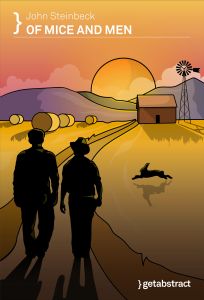
Of Mice and Men
- Novella
- Modernism
What It’s About
In the Land of Limited Opportunities
No one lives happily ever after in Of Mice and Men: Hope is as dead as a dormouse from the first page. Things go from bad to worse when an old dog, a young puppy, a vibrant young woman and a child-like giant of a man die in quick succession. But more than anything, the dreams of friendship and a dignified life die for those who survive. Published in 1937, the novella captures the devastating effects that Darwinian economics had on Depression-era America. Yet John Steinbeck wouldn’t be the undisputed master of American storytelling if he had not brightened up his bleak tale with some guarded optimism. “In every bit of honest writing in the world, there is a base theme,” he wrote in 1938. “Try to understand men; if you understand each other, you will be kind to each other. Knowing a man well never led to hate and nearly always leads to love.” Hope, in Steinbeck’s work, always dies last.
Summary
About the Author
John Steinbeck was born on February 27, 1902, in Salinas, California. He was of German-Irish descent. In 1919, he left to study English literature and journalism at Stanford University in San Francisco, yet he didn’t particularly enjoy student life. He found the odd jobs with which he paid for college much more relevant. Like many of the characters in his later novels, he worked on farms, in construction and in factories. In 1925, he dropped out and went to New York to establish himself as a writer but soon after returned to California. His first three novels were largely ignored, before he managed his literary breakthrough with the picaresque novel Tortilla Flat. Steinbeck then worked as a journalist, describing the fate of migrant workers during the Great Depression. His impressions from this time shaped the two novels Of Mice and Men (1937) and The Grapes of Wrath (1939). The latter became an international success and made Steinbeck the best-known, most talked about American author at the time. Yet conservatives treated him with increasing hostility, tarring him as a communist for his unveiled critique of capitalism. During World War II, he covered Italy as a war reporter and subsequently traveled throughout Europe, North Africa and Russia. With his 1952 novel East of Eden, he landed another great commercial success. Steinbeck, who by now had been married for the third time, hit the road again with his poodle Charley, traveling the United States in a converted truck. He wrote an article series about his experience that was published in the 1962 book, Travels with Charley. That same year, he was awarded the Nobel Prize in Literature. He died of heart failure on December 20, 1968, in New York City.








Comment on this summary